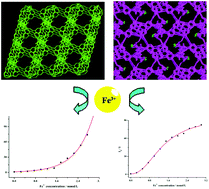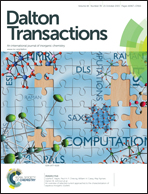Two porous luminescent metal–organic frameworks: quantifiable evaluation of dynamic and static luminescent sensing mechanisms towards Fe3+†
Abstract
Two novel porous luminescent metal–organic frameworks (MOFs, 1 and 2) have been constructed using 3,4-di(3,5-dicarboxyphenyl)phthalic acid using a hydrothermal method. Both MOFs can work as highly sensitive sensors to Fe3+ by luminescent quenching. Analyses of the structures indicate a higher quenching efficiency of 2 because of the existence of active –COOH groups. Based on this consideration, the quenching mechanisms are studied and the processes are controlled by multiple mechanisms in which dynamic and static mechanisms of MOFs are discussed. Besides, the corresponding dynamic and static quenching constants are calculated, achieving the quantification evaluation of the quenching process. As expected, experimental data show that compound 2 possesses an overall quenching efficiency 6.9 times that of compound 1. Additionally, time-dependent intensity measurements, the shifts of the excitation spectrum and the appearance of a new emission peak all give visual proofs of the distinct mechanisms between the two MOFs.


 Please wait while we load your content...
Please wait while we load your content...